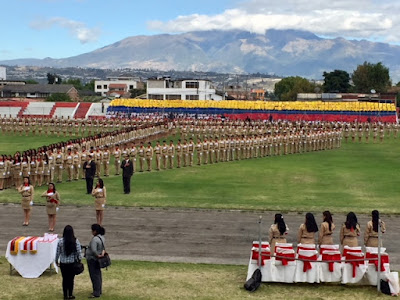“Salve oh Patria!”
“Hail our Homeland!”
These are the first lines of the Ecuadorian National Hymn which is sung loudly and proudly to the raising of the flag at the beginning of every public or private ceremony. I’ve learned to expect it because civic pride and patriotism are imbedded throughout the Ecuadorian culture. But on September 26, I learned a lot more about the depth of their national commitment. On this day, every school celebrates all that Ecuador was, and is today, with National Flag Day. And on this day, all across the country, every Senior in High School makes a pledge to honor their country. It’s a very big deal.
Ecuadorians in general love pomp and circumstance, and after four entire days of watching the students practice, I should have known this ceremony was very special. It started with the band and cheerleaders leading the procession into the stadium.
Then, from all directions came the flag bearers and the seniors marching in precise synchronicity to the drum beat of the band. They looked very professional in their formal uniforms and white gloves.
As the students paraded in, they formed the letters of the school name. They marched so slowly and ceremoniously, it took 30 minutes for the procession to finish.
After this, a group of students with the highest academic grades came forward and they were given sashes and pins by their parents to note their accomplishments. And then their parents were honored with certificates for raising such a good student and citizen of Ecuador. Finally, the top three students were given the honor to hold the country, county and city flags during the rest of the ceremony.
My school is named Teodoro Gomez de la Torre, for it’s founder Teodoro Gomez. After the school song, students also participated in a chant in honor of their “Patron”, or historical patriarch of the school. The leader of the chant is the Student President.
Next, the Ecuadorian flags were presented. In the flag, the yellow represents the bountiful corn or gold (depending upon who you ask… both important resources for this country). The blue represents the beautiful seas and skies. And the red represents the blood of all those who fought to save this country in their wars for independence.
Finally, all the seniors stepped forward in synchronized lines to bow down and make a promise to their flag, and their country. Ecuadorians are a very proud people, they know their history, and they know they have a responsibility to help their country be the best it can be. Notice the different color backgrounds. The students of younger grades were seated in the bleachers. They were all holding cards and with a signal, they turned them to either the colors of the Ecuadorian flag (yellow, blue and red), or they turned them to their school colors (red and white).
As I sat in the stands watching this, several of the teachers around me asked if the United States has ceremonies like this to honor our flag and make a commitment to our country. “No”, I responded. “Not like this.” “And why not?”, they asked. I found it hard to explain. Is it because we are so big and so diverse, that our population pledges to many different flags? Is it because there is already so much puffed-up patriotism lauding USA as the best country in the world, that we don’t need an additional ceremony to pledge our commitment? Is it because we instead choose to honor the service of our current and past Veterans during holidays such as Memorial Day? I’m not sure of all the reasons, but I am very enamored with the efforts this small country takes to enlighten and empower its own.
I’ve seen Ecuadorian’s sense of civic duty ingrained in other parts of life as well. Although there is no requirement of service to join their Army, Navy or Air Forces, these are common career choices for young men and women. Ecuadorians also read newspapers and watch the news. Everybody knows what’s going on politically, and they all have an informed opinion. I have witnessed many passionate discussions between family members, neighbors, friends, and co-workers of both genders about political happenings. They also vote. Everybody votes. Ecuador is a Representative Democracy and voting is taken very seriously by all. I’ll let a few websites from Google explain:
Later Addition:
Over the preceding week, classes were cancelled for 2-hour blocks of time to allow for Student Government campaigning. Three parties of Presidents and Vice Presidents were campaigning for the right to represent the students’ voice. I saw conga-lines and loud chanting, banners hanging off of rooftops and even a bubble machine to win some votes. When voting day finally arrived, all classes were cancelled for the day to honor this important civic duty. Students lined up alphabetically at assigned classrooms, signed their name on an official registry, voted with an official ballot and put it in the box. Even though all candidates for President were seniors in the high school, all students were required to vote.
| Here’s one teacher explaining to her first graders how to only vote for one choice. |
| Teachers administered the voting of each class. |
| The corridors were packed with students waiting in line to vote. |







